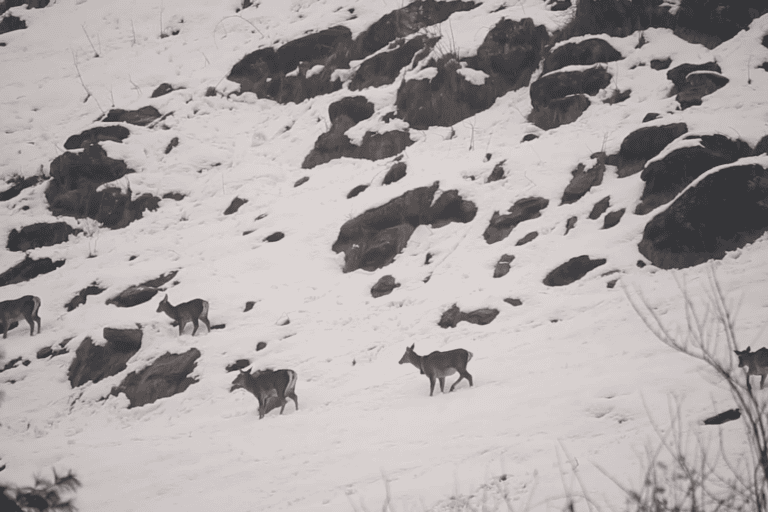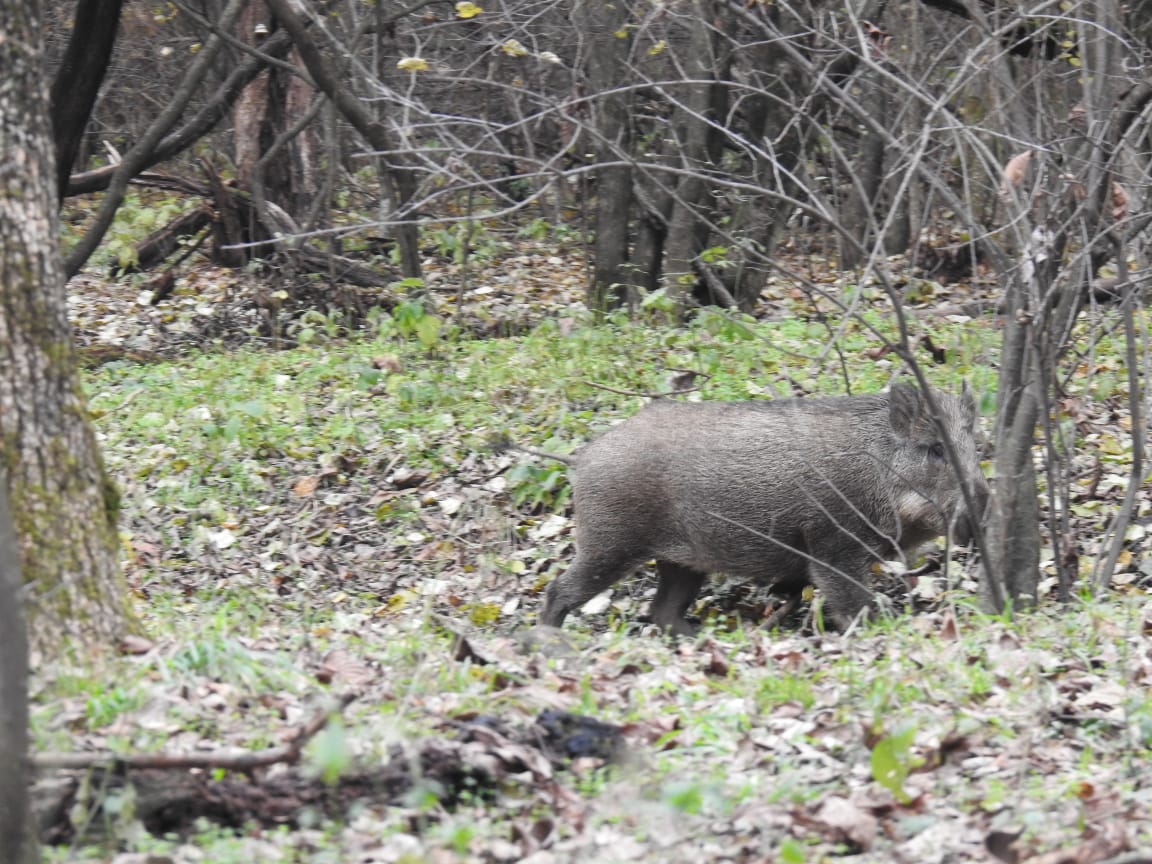- Sightings of the fast-breeding wild boar have been increasing in Kashmir, note citizens, farmers and wildlife conservationists. The species is not native to the region and was declared locally extinct in the 1980s until a sighting was recorded in 2013.
- The boars are increasing the competition for resources, for the critically endangered hanguls in Dachigam National Park. Farmers also allege that the wild boars are damaging farmlands by uprooting their crops.
- Wildlife experts say that increasing temperatures may have led to the resurgence of wild boars in the region. The Department of Wildlife Protection is conducting a detailed study to understand more about the presence of wild boars in Kashmir.
Wild boars resurfaced in Kashmir after 30 years, in 2013, and their number has been growing ever since, causing concern among the local residents and wildlife experts. Although an official census is yet to be taken, forest officials estimate about 200 wildboars (Indian boar, Sus scrofa cristatus) in Kashmir. The fast-breeding boars have been sighted in North Kashmir’s Uri, Limber, Lachipora, and Balwar. They have also been sighted in Dachigam National Park in central Kashmir, which, according to wildlife experts, could disturb the ecology of the critically endangered hangul, as both animals share the same habitat.
Wild boars are not native to Kashmir and were first introduced in the region during the time of Maharaja Gulab Singh (1846-1857), the erstwhile ruler of Jammu and Kashmir.
Intesar Suhail, a senior officer with the Jammu and Kashmir’s Wildlife Department, who has co-authored a 2017 study on wild boars, explained that wild boars were introduced by the Maharaja for hunting purposes. “The animal flourished for some time. Then in 1980, it vanished completely. It was not a native animal,” he said.
The wild pig was then recognised as an invasive species in Kashmir and thus, no steps were taken to conserve it, according to the study. The species was then considered locally extinct and was not sighted anywhere in Kashmir between 1984 and 2013. In 2013, Suhail came across a dead pig in the Limber and Lacchipora wildlife sanctuaries of the Kajinag range in North Kashmir. “This was the first (recorded) sighting of the wild boar after the 1980s. Since 2013, the animal has been sighted in various places. Presently, it is found across Kashmir. However, no census has been conducted to know the exact numbers of wild boars in the valley,” he told Mongabay-India.
Limber and Lachipora wildlife sanctuaries are situated in the Kajinag mountain range, which falls in Baramulla district in the northwest of the Kashmir valley. The area occupies the north bank of the river Jhelum in Uri close to the Line of Control between India and Pakistan on the northwestern side and the Shamshabari mountain range (Langate forest division of Kupwara district) to its north.
According to Suhail, increasing temperatures is one of the reasons for the resurgence of wild boars, as they do not sustain in the cold weather that is typical of the region. “We haven’t witnessed severe cold winters for the last several years. Kashmir needs two to three severe cold winters to cause a decline in wild boar numbers,” he said. He added that the boars may also have migrated from the other parts of Kashmir.
Competing with the Kashmir stag
Suhail points out that the impacts, both beneficial and adverse, of the wild boar resurgence, needs to be studied thoroughly. “The wild boars can cause competition in resources for the hangul, as both animals share the same habitat. But they can also be suitable prey for leopards. This in turn will reduce instances of leopards entering human inhabited areas in search of food,” he said.

In 2022-2023, the Jammu and Kashmir Government Wildlife Department conducted a six-month assessment of the wild boars at Dachigam National Park. Their study, Ecological Aspects of Wild Boars at Dachigam National Park, compared the food habits of wild boars and the hangul. The results showed that an increasing wild boar population can impact the ecology of Dachigam National Park and other parts of the valley.
Spread across 141 sq. km., Dachigam is best known as the home of the hangul or Kashmir stag, the state animal of erstwhile Jammu and Kashmir. The hangul is a critically-endangered species as per the International Union for Conservation of Nature and Natural Resources (IUCN) Red List, and a Schedule I Species in as per India’s Wildlife Protection Act 1972.
The number of hanguls have declined since the beginning of the 20th century, when it was estimated to be around 3000 to 5000. While there have been varied estimates of hangul population over the years, with differences in data between official population statistics and independent research, it is certain that the population lies somewhere between 100 and 261.
“Boars are in direct competition for habitat, shelter, water and other resources, not only with the hangul but other animals too,” Aakib Hussain, a researcher, told Mongabay-India.
“The rapid increase will have serious consequences in the future,” Hussain added.
Farmers worry as wild boars uproot crops
Wild boars are prolific breeders and can damage crops including eating roots and digging up the land,” Hussain told Mongabay-India. “During my research, I saw that they have uprooted soil in vast scales, like tractors ploughing a field. If not controlled, they will soon reach saffron fields and damage the crops of one of the costliest spices of the world,” he said.
Wild pigs use their tough snouts to excavate soil in search of plant roots, said Bashir Ahmad, a botanist based in Kashmir. “Wild pigs often feed in large groups and can completely destroy a small paddock in a short period. This makes them a foe to the organic carbon stored in soil. When soils are disturbed, carbon is released into the atmosphere as a greenhouse gas,” he explained.
Mohammad Ishaq Khan is a 50-year-old farmer in Uri in North Kashmir’s Baramulla district. For the past 30 years, he has been cultivating an average of four to five quintals of maize over three kanals of land (20 kanals = one hectare). However, since 2022, the produce he gets has dropped in quantity because of damage by wild boars that have resurfaced in Kashmir and growing in numbers over the past decade.
“Last year, I could produce only 2.60 quintals of maize as wild boars caused a lot of damage to the crop. They have caused havoc in several areas of North Kashmir, including Uri, by damaging crops like maize, rice and also mango and apple trees,” said Khan, who lives with his wife and two sons.
This year, many farmers have stationed people in their fields to drive the wild boars away. “I have also raised a temporary fence to stop pigs from entering our field. These are, however, temporary precautions. The government has to take this issue very seriously,” Khan added.
Abdul Hameed, another farmer from Uri, said it was difficult to keep boars at bay, as they mostly come at night. “We can’t go to our fields during night hours as there are chances of encountering wild animals like leopards and bears. There are also army men patrolling. Last year, there were many incidents when wild boars damaged the wooden fencing and uprooted crops in various fields,” he added.

Wildlife experts say that a detailed study on the wild boars is imperative. Nadeem Qadri, Executive Director, Wildlife Conservation Fund, Jammu and Kashmir, says that the Department of Wildlife Protection will implement effective measures to control the surge in the wild boar population. “The Department is currently conducting a comprehensive study on this pressing matter, and we are eagerly anticipating the results from the experts,” he said.
Watch: [Video] Hangul, the shy Kashmiri deer, is facing the threat of extinction as its habitat shrinks
Banner image: A wild boar in Dachigam National Park. Photo by Aakib Hussain.
